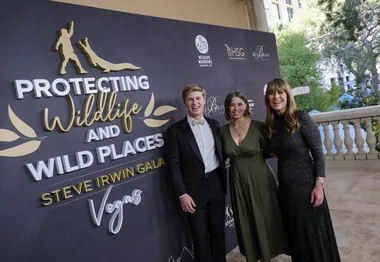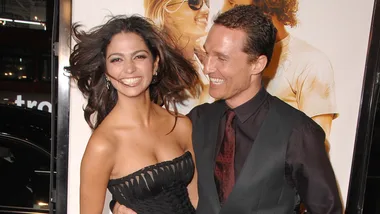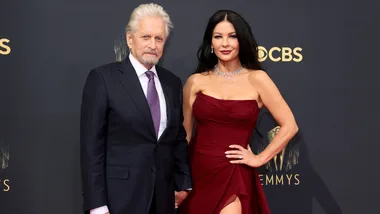A flash of hand-knitted yellow cardigan sighted through the church fence marks the start of a day which has been years in the making for Melissa Doyle and her daughter, Talia Dunlop. As their World Vision sponsor child cautiously rounds the corner clutching her mother’s hand, emotions quickly spill over; tears misting the eyes of all there to bear witness. While Talia bends down to hand four-year-old Bridget a stuffed koala bear, Mel and Fraciah embrace, two strangers brought together by their love for their children and their hopes for their future.
“I’m so happy and I don’t know how to express it,” Fraciah says as the two women step back from their hug, “but I am thankful.” Then all turn their attention to Bridget who – over the course of their afternoon visit – slowly morphs from shy to exuberant, singing for her visitors, drawing pictures, writing out the alphabet and happily playing games. This is a scene Mel has witnessed several times in her 20-year stint as a World Vision ambassador; albeit one that never gets less affecting. For 18-year-old Talia – who joined the charity as a youth ambassador in 2019 before COVID-19 scuppered her debut trip the following year – it’s been a revelation. Not only of the work her mother has been quietly undertaking for two decades but also of the impact their sponsorship is having on this community, and many others around the world.
Mel and Talia have invited The Weekly along to take part in this mother-daughter trip to Kenya which starts with a sweet first meeting but will soon take us across the country to see the effects devastating drought and poverty have wrought and the extraordinary people working to lift communities out of it. It’s a journey that will be punctuated with tender moments between the duo, as well as one that opens eyes with the occasional confronting truth along the way. But for now, back in the car and bumping up the dusty road, once we’ve said our reluctant goodbyes, mother and daughter can’t keep the smiles off their faces.
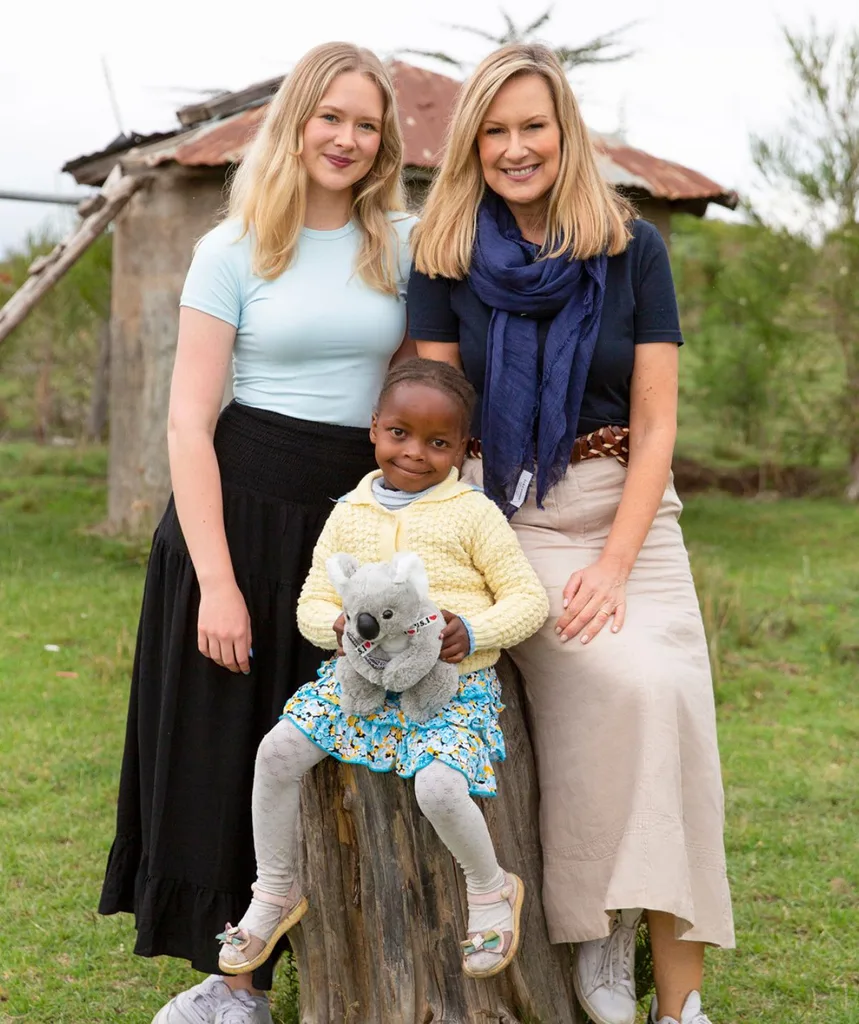
Talia and Mel finally meet Bridget, their sponsor child.
(Credit: (Image: Jordan Montgomery))“Meeting Fraciah was just extraordinary,” Mel reflects of the emotional moment the two shared. “There is a bond before you even meet. It’s an understanding with another mother where you are humbled by help for your child. I would hope, if it was ever necessary, that someone would step up for mine. There’s a code between women – not just mothers but aunts, sisters, godmothers – that you look out for each other’s children.”
“I really tried to hold my tears back,” Talia adds. “I’ve heard Mum talk about our sponsor children and we’ve got the photos on the fridge – I’ve grown up knowing about it. Now I can see what it does, not just for the individual child, but the community.”
It’s a common misconception, explains Mel, that the money you donate to a sponsor child goes solely to their own education and upbringing. Within Bridget’s community there are 176 children in total who need support – yet only 84 are sponsored. Luckily for those still on the waiting list, the money coming in goes to ensuring the school has better facilities, clean water all can access, plus health services and nutritional advice. So yes, there’s a way to go, but at the end of the day, all the children in the community and their extended families will benefit.
“The more people who are sponsored in that area, the bigger the pot,” she sums up.
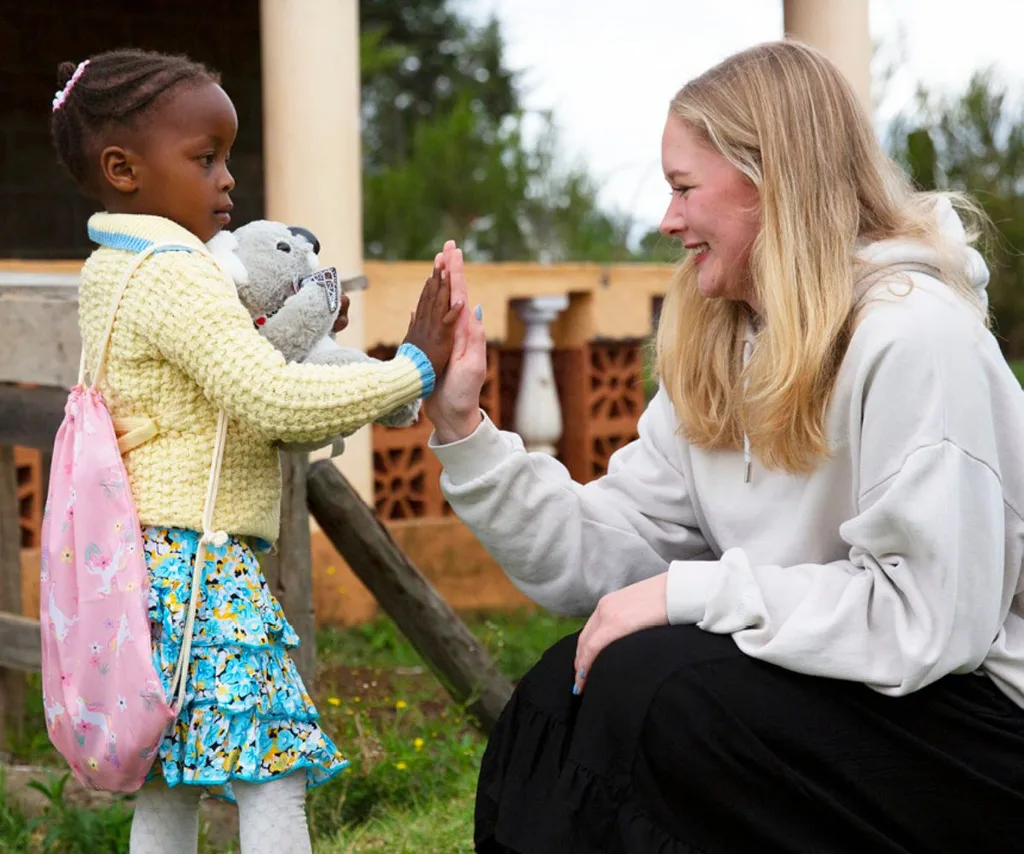
Talia and Bridget bonded quickly.
(Credit: (Image: Jordan Montgomery))A country in crisis
Currently, Kenya is in the grip of the most devastating drought to hit the region in 40 years. As we wind up a long country road, the signs are obvious. Dust is thick in the air, the ground rocky and arid. The cows attempting to graze or snooze along the roadside are clearly emaciated. Some farmers have lost most – if not all – of their livestock thanks to the extreme conditions. For university student Talia, who has grown up with climate change as a hot-button issue, it’s an eye-opening look into a topic she’s already passionate about. “Climate is obviously a big problem, it’s on everyone’s minds,” she says. “Everything you see and do always comes back to it.”
So, our next stop is one she’s keen to see. Ahead of our trip, we’d all met with Tony Rinaudo, an Australian agriculturalist with the nickname ‘The Forest Maker’. In the early 1980s, Tony set out to attempt to grow trees in dry and degraded lands in the desert of Niger. The idea was a simple one – although not a new concept. Tony promised that the trees would provide shade, windbreaks and organic fodder for land and animals, as well as helping to regreen the area which had been cleared of bush to make way for farmland. Yet nothing he did seemed to work – trees simply wouldn’t grow. “It was expensive. It has a very high failure rate. It’s slow, and that was my experience in Niger,” Tony explained. The locals called him “the crazy white farmer” and Tony thought about giving up. But then he had his classic “aha” moment.
Locals had been cutting back what they thought were invasive shrubs. But looking closer, Tony realised they were cutting back the regrowth of tree stumps that had been felled many years earlier. Now all he needed to do was identify which trees they could regrow from the ground up. That moment spawned a program called FMNR (Farmer Managed Natural Regeneration) and it’s having an astounding impact across Africa and beyond. The program is one of World Vision’s central pillars for its goal to end extreme poverty.

A Saving for Transformation group gave Mel and Talia traditional blankets to thank them for their visit.
(Credit: (Image: Jordan Montgomery))Today we’re meeting David Korir, the lead farmer within his community. We turn left after driving through what seems like an endless sea of brown, and a vision unfolds. “It’s a green field,” Talia points out excitedly. “The whole hour of driving we’ve done, everything was so dead, and here is a farm and it’s green and it’s alive.”
We jump out of the van and an excited David strides up to meet us. He’s spent four years of backbreaking work on his fields which were once rocky outcrops and he’s proud to show the fruits of his labour. His land is a stark contrast to that of his neighbours, whose cows, he says, wander in for a free feed every now and again. The reward for him and those locals who are taking up the program after seeing David’s success, he assures us, was worth every tough day spent to achieve it.
Handing Mel a machete, he shows her how to prune trees to help them flourish rather than stunt them. Bemused, she gives it her best shot, before walking down to see his heaving mango trees and help feed his happy herd of cows. “I could be a farmer’s wife,” she declares with a chuckle as Talia listens keenly to the stories of how the simple changes have had a radical impact on the locals. “I find it really interesting – the impact on the greater community that it’s having,” she says. “It’s not just David and his farm, not just his neighbours. They have so much food they can give to everyone in the greater community, the animals can be sold on, it opens up jobs, it’s a trickle-down effect. And that’s power to David – he’s sharing his knowledge and passing it on.”
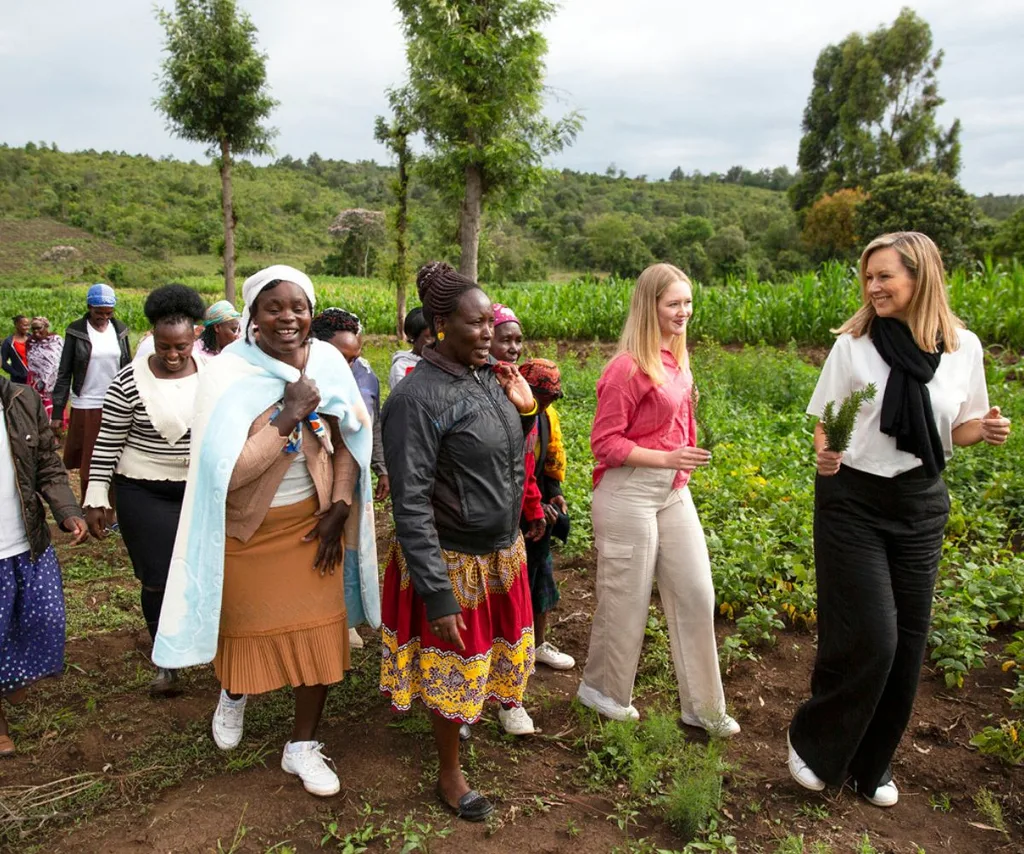
Mel and Talia with the local Saving for Transformation group, who turned arid farmland into a thriving operation.
Women on top
For World Vision, empowering women and children has always been a top priority. The following day we see two instances of that – first with a Child Protection group and secondly with a Savings for Transformation group. “Over the years I’ve definitely learnt about the effect of poverty and what that will force people to do,” Mel says. “Children and women are the first to feel that. So, the more we can communicate, the more we can offer alternatives, the more we can teach families, the better.” That’s why these groups are so crucial.
Sadly, in this area of Kenya, child abuse and neglect are huge issues. Drug addiction, child prostitution and incest are just a few of the issues tackled by the Child Protection Group, which is comprised of local community leaders – from the police officers to church leaders and teachers – who work with kids. We listen to the specific case studies, and it’s confronting stuff. Not only are adults harming the young, but children are harming themselves and others. Yet learning how these groups are slowly but surely helping kids to speak up and know their rights, as well as their responsibilities, is inspiring.
“I was in awe of how specific and targeted [the program] was,” Mel says later. “The fact that they line up a variety of people to help – who look at the issue from every possible angle you can look at it from and then figure out exactly what the children in this particular community need. It’s a bit like, if you were to take it from suburb-to-suburb here in Australia: The needs are vastly different in different areas. It’s making a tangible difference.”
“It was a bit confronting to hear what these children have gone through at such a young age, younger than me,” adds Talia. “And with the children it was more of a focus on the ‘why’. Is there something else that is causing them to do this? Are they not aware it’s wrong? At that age, is it behaviour that is learnt at home? Or are they a victim themselves, which makes them think it’s the right thing to do? “I remember having that same conversation about how rights and responsibility work hand-in-hand years ago when I was at school. For example, you have a right to free speech. But you have a responsibility that when you are speaking freely, you do it respectfully. It’s a universal thing, so I found it was interesting to hear they are doing the same here.”

Mel and Talia visit the local school.
(Credit: (Image: Jordan Montgomery))In the rural regions of Kenya, the patriarchal system is very much present. Men rule when it comes to the finances, while women are tasked with caring for the home and the family. With unemployment rates in Kenya among the highest in East Africa, many of the women we met on this trip were struggling to feed, clothe and educate their children. And with no access to bank accounts or money of their own, this was only fuelling generational poverty and inequality.
So, the introduction of World Vision’s Saving for Transformation groups – which are entirely female led and owned – is particularly significant in this region. In a nutshell, a group of between 15 and 30 women each pay a small amount of money towards a communal pool which aims to help them save, invest and grow their farms and local businesses. The group we meet today has turned once arid farmland into a thriving and profitable operation. They are growing crops, making their own chicken feed, selling eggs. And, rather than keeping individual profits for themselves, they employ a “merry-go-round scheme” which sees that money go into things that will eventually advantage all.
As they sit down to share their stories with us, it’s powerfully clear that this is transforming the lives of the women and children here. One of the older women has now saved enough not just to put her kids through school, but to send them on to further education in the city – something that never would have been possible prior to this project. “It feels so proactive,” says Mel. “I love that they use their money to uplift one another. They all pitch in and do it as a group project. And I love the idea of them being the main breadwinners. Without their income, I wonder how many of their kids would be going to school.”
It’s a valid question. When The Weekly asks the women if they’re now out earning their husbands, it’s clearly a sensitive subject. They dance around it and admit they “surprised” the men after the project was a success, rather than informing them of what they were doing early on. “A lot of the men in this region drink their money away,” a World Vision support worker tells us quietly later. “So, for the women, this is a relief to finally be able to look after their families and not to have to worry.”
As we reflect upon the day later, Mel sums up another key benefit of this work. “These mothers are able to pass on to their children [the knowledge] that if you can lift yourself out of a situation, you can change it,” she muses. “It’s a great example, not only for the girls but for their sons. It’s got to be a great thing in a patriarchal society to have a young man see what these women are doing. What a great lesson to learn. And what better way to learn it than from your own mum.”
The lessons passed along from mother to child is a topic clearly playing on both Mel and Talia’s minds as we wrap up our visit and prepare to leave Kenya. For Talia, it has been an insight into the work that often took her mum away from home during her formative years. But for Mel, it’s also given her a new key learning: That the daughter she has raised to help others whenever possible is not only following in those footsteps, she’s doing it under her own steam. “It blows me away how wise she already is,” Mel says as Talia semi-squirms at the praise. “How insightful and how interested. [My husband] John and I have always striven to make sure our kids have open minds and are keen to learn and find out more about the world outside of the bubble in which they live.
“Watching her ask questions, be interested, wanting to know why things are being done the way they are makes me really proud.”
To learn more about World Vision’s child sponsorship program and the work it does across the world, head to worldvision.com.au.
You can read this story and many others in the May issue of The Australian Women’s Weekly – on sale now.

